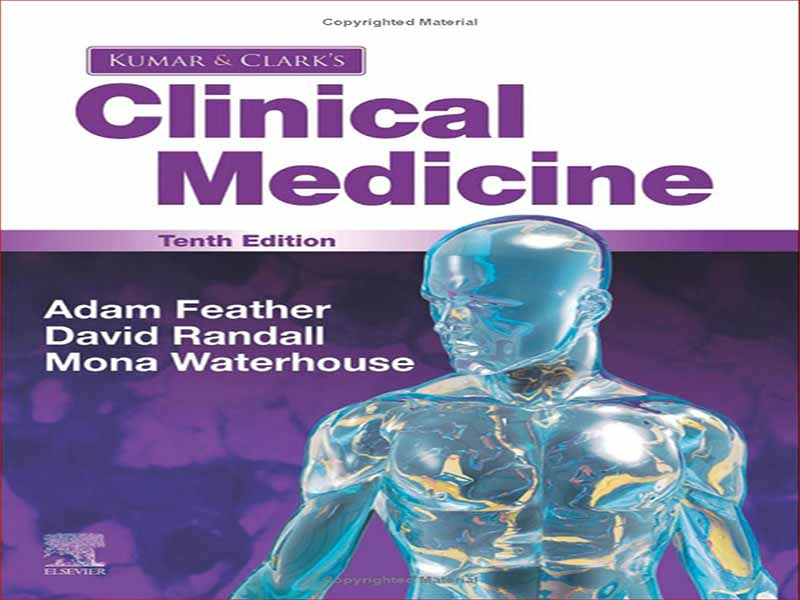- عنوان کتاب: Kumar & Clarks Clinical Medicine
- نویسنده: Adam Feather
- حوزه: پزشکی بالینی
- سال انتشار: 2021
- تعداد صفحه: 1508
- زبان اصلی: انگلیسی
- نوع فایل: pdf
- حجم فایل: 112.0 مگابایت
«باید دلیل خوبی برای نوشتن یک کتاب درسی جدید پزشکی وجود داشته باشد، در حالی که تعداد خوبی در بازار وجود دارد.» بدین ترتیب مقدمه اولین نسخه پزشکی بالینی که 33 سال پیش در سال جاری منتشر شد، آغاز شد. «کومار و کلارک» که توسط پروفسور دیم پروین کومار و دکتر مایکل کلارک ویرایش شده است، نه تنها مترادف با یک کتاب درسی پزشکی، بلکه با ترکیبی از برتری و دسترسی که آنها به دنبال ارائه آن بودند، مترادف شده است. تمایل آنها به توانمندسازی دانشجویان و پزشکان بالینی از آن زمان تا کنون هدف اصلی این کتاب بوده است – «ایجاد تعادل بین پیشرفتهای جدید هیجانانگیز در تحقیقات پزشکی و مقدار عظیمی از واقعیتهای ثابتشده که باید جذب شوند… بهمنظور مدیریت بیماری. را می توان بر اساس مفاهیم صحیح فیزیولوژیکی استوار کرد. کتابی که آنها تولید کردند به یکی از پرفروشترین کتابهای پزشکی بینالمللی تبدیل شده است و نقش مهمی در آموزش نسلی از پزشکان ایفا کرده است – در میان آنها تیم جدیدی از ویراستاران که متواضع هستند تا روی شانههای این غولهای پزشکی بایستند. تصدی این مسئولیت یک افتخار و مسئولیت بزرگ است و ما از میراثی که آنها به جا گذاشته اند و همچنین از حمایت و کمک مداوم آنها در تولید این نسخه فعلی سپاسگزاریم. پزشکی بالینی همیشه تلاش کرده است که شکاف بین متون مقدماتی اولیه و آثار مرجع بزرگتر را پر کند: به همان اندازه قابل درک باشد که جامع باشد. سرعت پیشرفت علم پزشکی حیرت انگیز است. نسل کنونی پزشکان و دانشآموختگان جوان باید مراقبتهای باکیفیت و بیمار محور را در چارچوب تحقیقات پزشکی در حال رشد، بیمارانی که با بیماریهای چندگانه و پلیفارماسی ناشی از آن، تداوم نابرابریها در جامعه و سراسر جهان، و فرهنگ پزشکی ارائه میکنند، ارائه دهند. که از پزشکان انتظار دارد که در تیم ها کار کنند و شکاف های تخصصی سنتی و حرفه ای را برطرف کنند. به همین دلیل، ما تعدادی فصل جدید را برای تجهیز خوانندگان برای رسیدگی به این چالش های جدید در این نسخه معرفی کرده ایم: تمرین مبتنی بر شواهد (فصل 4)، جراحی (فصل 11)، بهداشت عمومی (فصل 14)، سالمندان. پزشکی، ضعف و چند بیماری (فصل 15)، انکولوژی هماتولوژیک (فصل 17) و سلامت مردان (فصل 40). در برخی موارد، ما فصلهای بزرگتری را برای برجسته کردن شرایطی تقسیم کردهایم که مرزهای فوقتخصصی سنتی را در بر میگیرد، اما نیاز به یک رویکرد مشترک دارد: سپسیس و درمان عفونت باکتریایی، (فصل 8)، بیماری ترومبوآمبولیک وریدی (فصل 29)، فشار خون بالا. (فصل 31) و طب مامایی (فصل 38). ما محتوای مهارتهای بالینی جدیدی را در ابتدای بیشتر فصلها گنجاندهایم تا اهداف تاریخی این کتاب را محقق کنیم: به کار بردن علوم بالینی بر روی مشکلاتی که بیماران در تمرینات پزشکی روزمره تجربه میکنند. ما امیدواریم خوانندگان یاد بگیرند که نه فقط شرح حال عمومی بگیرند و معاینات فیزیکی معمولی را انجام دهند، بلکه رویکرد خود را با توجه به ارائه هر بیمار در مقابل خود تنظیم کنند. ما برداشت خود را از روش بالینی و اهمیت ایجاد یک رابطه درمانی با بیماران در فصل اول جدید ارائه میکنیم و آنچه را که معتقدیم کلید هنر پزشکی باقی میماند شرح میدهیم: تشخیص (فصل 1). به صورت آنلاین، خوانندگان طیف وسیعی از منابع اضافی، از جمله سوالات خودارزیابی، صفحات موضوعی مرور کلی که شرایط اصلی را پوشش میدهند، ویدیوهای مهارتهای بالینی و پوشش گسترده موضوعات با ارتباط بینالمللی یا منطقهای خاص را پیدا خواهند کرد. امیدواریم این نسخه برای شما در تلاش برای یادگیری و تمرین پزشکی مفید واقع شود. هر پیشنهادی که بخواهید ارائه دهید به گرمی مورد استقبال قرار می گیرد و به ما کمک می کند تا اطمینان حاصل کنیم که این کتاب همچنان نیازهای خوانندگان خود را برآورده می کند.
‘There must be a good reason to write a new textbook of medicine when there are already a good number on the market.’ So began the preface to the First Edition of Clinical Medicine, published 33 years ago this year. Edited by Professor Dame Parveen Kumar and Dr Michael Clark, ‘Kumar and Clark’ has become synonymous not just with a medical textbook, but with the combination of excellence and accessibility they sought to provide. Their desire to empower clinical students and doctors has been the driving ambition behind the book ever since – ‘to strike a balance between exciting new developments in medical research and the vast quantity of established fact that needs to be absorbed… so that the management of disease can be based on sound physiological concepts’. The book they produced has become an international medical best-seller, and has played a crucial part in the education of a generation of doctors – among them a new team of editors, humbled to be standing on the shoulders of these medical giants. Taking over is an honour and a great responsibility, and we are grateful for the legacy they have left, as well as for their continued support and input as we have brought this current edition to production. Clinical Medicine has always attempted to bridge the gap between basic introductory texts and larger reference works: to be as comprehensible as it is comprehensive. The pace at which medical science continues to develop is astounding. The present generation of junior doctors and undergraduates must provide high-quality, patient-centred care in the context of a burgeoning body of medical research, patients presenting with multimorbidity and resulting polypharmacy, continuing inequalities in society and across the world, and a medical culture that expects doctors to work within teams, bridging traditional specialty and professional divides. For this reason, we have introduced into this edition a number of new chapters to equip readers to address these new challenges: Evidence-based practice (Ch. 4), Surgery (Ch. 11), Public health (Ch. 14), Geriatric medicine, frailty and multimorbidity (Ch. 15), Haematological oncology (Ch. 17) and Men’s health (Ch. 40). In some cases, we have divided up larger chapters to highlight conditions that straddle traditional subspecialty boundaries but require a joined-up approach: Sepsis and the treatment of bacterial infection, (Ch. 8), Venous thromboembolic disease (Ch. 29), Hypertension (Ch. 31) and Obstetric medicine (Ch. 38). We have included new clinical skills content at the beginning of most of the chapters to try to fulfil the historic aims of this book: bringing the clinical sciences to bear on the problems experienced by patients in day-to- day medical practice. We hope readers will learn not just to take generic histories and perform routine physical examinations, but to tailor their approach according to the presentation of the individual patient in front of them. We offer our own take on the clinical method and the importance of building a therapeutic relationship with patients in a new first chapter, describing what we believe remains key to the art of medicine: diagnosis (Ch. 1). Online, readers will find a range of additional resources, including self-assessment questions, bite-sized overview topic pages covering major conditions, clinical skills videos and expanded coverage of subjects with particular international or regional relevance. We hope you will find this edition helpful in your efforts to learn and practise medicine. Any suggestions you may wish to make are warmly welcomed and will help us to ensure that this book continues to meet the needs of its readers.
این کتاب را میتوانید بصورت رایگان از لینک زیر دانلود نمایید.
Download: Kumar & Clarks Clinical Medicine




































نظرات کاربران